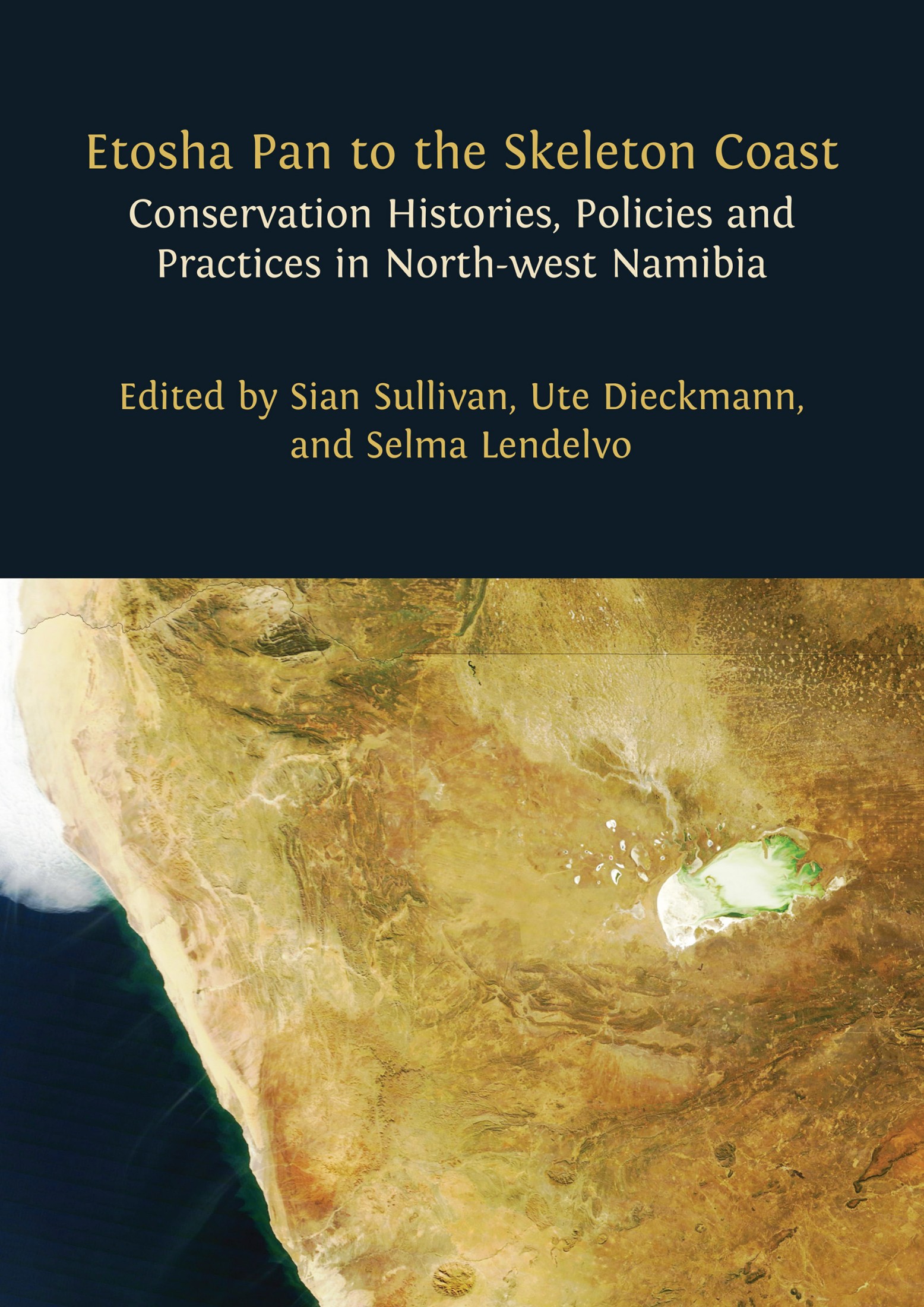19. Relationships between humans and lions
in wildlife corridors through CBNRM in
north-west Namibia
©2024 Uakendisa Muzuma, CC BY-NC 4.0 https://doi.org/10.11647/OBP.0402.19
Abstract
Protected areas are considered essential for conserving large carnivores, although large carnivores also occur outside protected areas and have shared landscapes with humans for millennia. The Namibian Community-Based Natural Resources Management programme adopted in 1996 aims to devolve wildlife conservation practices and to benefit local people inhabiting communal areas. The programme is experiencing challenges, but has achieved some success in encouraging the coexistence of wildlife and rural communities on communal land. Because the programme is built upon human-wildlife coexistence, however, human-lion conflict is also present. This has been a pressing concern, particularly regarding people’s willingness to coexist with dangerous animals such as lions. From a wildlife conservation perspective, a lack of monitoring of human settlement and livestock movement into conservancy areas zoned for wildlife is a concern. This chapter discusses current research from remote sensing of lion and goat movement using satellite-Global Positioning System collars, focusing on understanding goat movement ecology within designated wildlife areas. Information collected on goat movements within wildlife areas will be used to better manage the shared landscape in the perceived “corridor” between Etosha National Park and the Skeleton Coast National Park. The research shared here thus focuses on the “lion-goat space”, contributing to evidence-based goat spatial habitat use in communal area conservancies to ensure appropriate deployments of human-lion conflict mitigation measures.
19.1 Introduction
Protected areas (PAs) are essential for conserving wide-ranging large carnivores, to support their basic ecological needs. At the same time, large carnivores also occur outside PAs and have shared landscapes with humans for millennia. African PAs suffer dramatic budgetary shortfalls, as Lindsey et al.1 have shown. The future of PAs is uncertain, and conservationists need to diversify the spaces where carnivores can survive to cope with this uncertain future. Conservationists have thought of methods to promote human-carnivore coexistence, such as conflict mitigation programmes, compensation schemes and payments for “ecosystem services”2 to ensure viable carnivore populations beyond PAs, habitat protection, maintaining ecosystem services, and securing local community livelihoods.3
Striking a balance between livestock production, pastoral mobility, and wildlife conservation is a challenge facing 21st-century conservationists.4 Several studies have extensively explored various types of human-wildlife conflict (HWC), ranging from crop-raiding, livestock predations, and infrastructure damages, to loss of human lives.5 Packer et al.6 indicated that minimising negative conservation impacts caused by human land use can be attained by separating conflicting activities instead of encouraging coexistence. Land-use patterns incorporating livestock and large carnivores in a single system are not ideal, with physical separation using barriers being highly effective for conserving lions (Panthera leo), due to negative interactions between livestock and wildlife.7 Other studies indicate a positive perception of livestock-carnivore coexistence owing to adjusted livestock husbandry practices such as moderate grazing.8 These studies, however, were conducted elsewhere (North America, Asia and East Africa). Few peer-reviewed scientific studies, particularly in the Namibian context, examine human-carnivore coexistence.9 Lessons can be drawn from studies conducted elsewhere, but at the same time, each area has unique social, environmental, economic, and ecological challenges that must be considered to manage such a system effectively. Human-wildlife conflict occurs when wildlife’s ecological and biological needs negatively impact human well-being, and vice versa.10 For instance, humans killed by lions are a severe problem in Ethiopia, Tanzania and Mozambique.11 Meanwhile, livestock predation is a pressing challenge in southern African countries, such as Botswana and Namibia.12 The interaction between humans and large carnivores may result in human-lion conflict (HLC) specifically, and may negatively impact large carnivore survival.13
HLC arises where humans and large carnivores share space and resources, and may become detrimental to carnivore survival. A lack of availability of prey resources may also drive large carnivores into proximity with humans, with retaliation by humans an outcome of this proximity.14 This chapter will therefore discuss a research project undertaken in the Kunene Region regarding human and lion coexistence in communal conservancy areas between the Etosha and Skeleton Coast National Parks: framed as a “wildlife corridor” between these two protected areas (see Chapters 3 and 13). The chapter focuses on remote sensing of lion and goat (Capra hircus) movement using satellite-Global Positioning System (GPS) collars (see also Chapters 17 and 18), with a focus here on understanding goat mobilities within conservancy areas where wildlife species are also present (also see Chapter 8). It is intended that information collected on goat movement within wildlife areas will assist with better management of the shared landscape between Etosha National Park (ENP) and the Skeleton Coast National Park (SCNP). The chapter will focus more on the lion-goat interface in communal area conservancies to ensure appropriate deployments of HLC mitigation measures.
19.2 Community-Based Natural Resources Management (CBNRM) and the lion-goat interface
The Namibian government officially introduced the Community-Based Natural Resources Management (CBNRM) programme in 1996. It aims to devolve wildlife conservation practices and benefits to local people inhabiting communal areas.15 To date, the programme has achieved successes,16 in part through a focus on sustainable harvesting of wildlife through hunting and meat consumption, as well as through a focus on tourism investment.17 These aims have encouraged coexistence of wildlife and rural communities on communal land areas: through practice and collaboration with various stakeholders, residents coexist with and benefit from nature,18 building on past histories and ecological knowledge. Currently, however, the north-west of Namibia is experiencing wildlife declines as an outcome of a decade of dry years and high levels of harvesting into this dry period, meaning that offtake quotas are currently very reduced with corresponding reductions of income from this source, as discussed in Chapter 3.
At the same time, because the CBNRM programme is built on human-wildlife coexistence, human-wildlife conflict (HWC) is also present. It has been a pressing challenge, particularly in relation to people’s coexistence with dangerous animals such as lions. The challenges to this system became evident as never before during the 2010s. As mentioned, this was a dry period in which prey populations fell and lions and other predators turned increasingly to peoples’ livestock for sustenance (see Chapters 17 and 18). Retaliatory human killing of lions has garnered local and international attention.19 The former Ministry of Environment and Tourism (MET) reported an adult lion mortality rate of 80% and a 100% mortality of sub-adults caused by conflict with humans between 2000 and 2015.20 The authors further indicated that male lion mortality is causing a skewed population sex ratio of 5.4 females to 1 male in the desert-adapted lion population of north-west Namibia. Human-lion conflict (HLC) and the uncertain effects of drought will continue to challenge the community conservation paradigm during the 2020s (also see Chapter 3).
Due to the unpredictable rainfall coupled with frequent droughts, pastoralists move long distances searching for water and grazing for their livestock, including wildlife-designated areas, thus increasing the chances of HLC as well as conservancy issues relating to the management of these mobilities (see Chapter 6).
The range of lions in north-west Namibia extends into communal area conservancies. About 36 conservancies have either resident or transient lions.21 The Ministry of Environment, Forestry and Tourism (MEFT) identified four core lion-range conservancies with the highest HLC using available data22 (see Figure 17.2). Three communal conservancies of north-west Namibia, namely, Anabeb, Ehi-Rovipuka and Omatendeka, are identified with the highest HLC. These conservancies provide an ideal opportunity to study livestock–wildlife coexistence in the context of community conservation programs.
The three conservancies are unique due to their geographical location (see Figure 19.1). Their demarcated wildlife areas adjoin ENP on the western side, Hobatere Tourism Concession to the east, Etendeka tourism concession to the south, and Palmwag tourism concession to the south-west. The SCNP, with which lion populations in this area are also connected, is positioned to the west of these conservancies (although not adjoining the conservancies). These “wildlife areas” provide habitat and connectivity in this ecosystem, and provide an essential migrating and dispersal route for herbivores such as elephants (Loxodonta africana) (see Chapter 11) as well as predators such as lions.23
As part of their management plans, each conservancy has different land use zones (as shown in Figure 19.1). These include for wildlife—areas exclusively demarcated for wildlife breeding and reproduction, where no hunting takes place; settlements—areas zoned for human activities such as settlement; tourism—areas zoned for tourism activities with no hunting of wildlife; hunting—areas demarcated for sustainable hunting of wildlife, based on animal residing in those areas, although sometimes hunts may take place beyond those areas; and farming—areas demarcated for farming activities such as livestock and crop farming. However, no physical barriers separate these different zones. Therefore, wildlife, livestock and people are regularly in close contact. Due to the prolonged drought, some farmers have settled in or near wildlife areas to find suitable grazing for their livestock (on mobility practices, also see Chapters 3 and 6). Increased HLC incidents are attributed in part to these practices, resulting in loss of livelihood from lions and subsequent retaliatory killing of lions and other predators.24
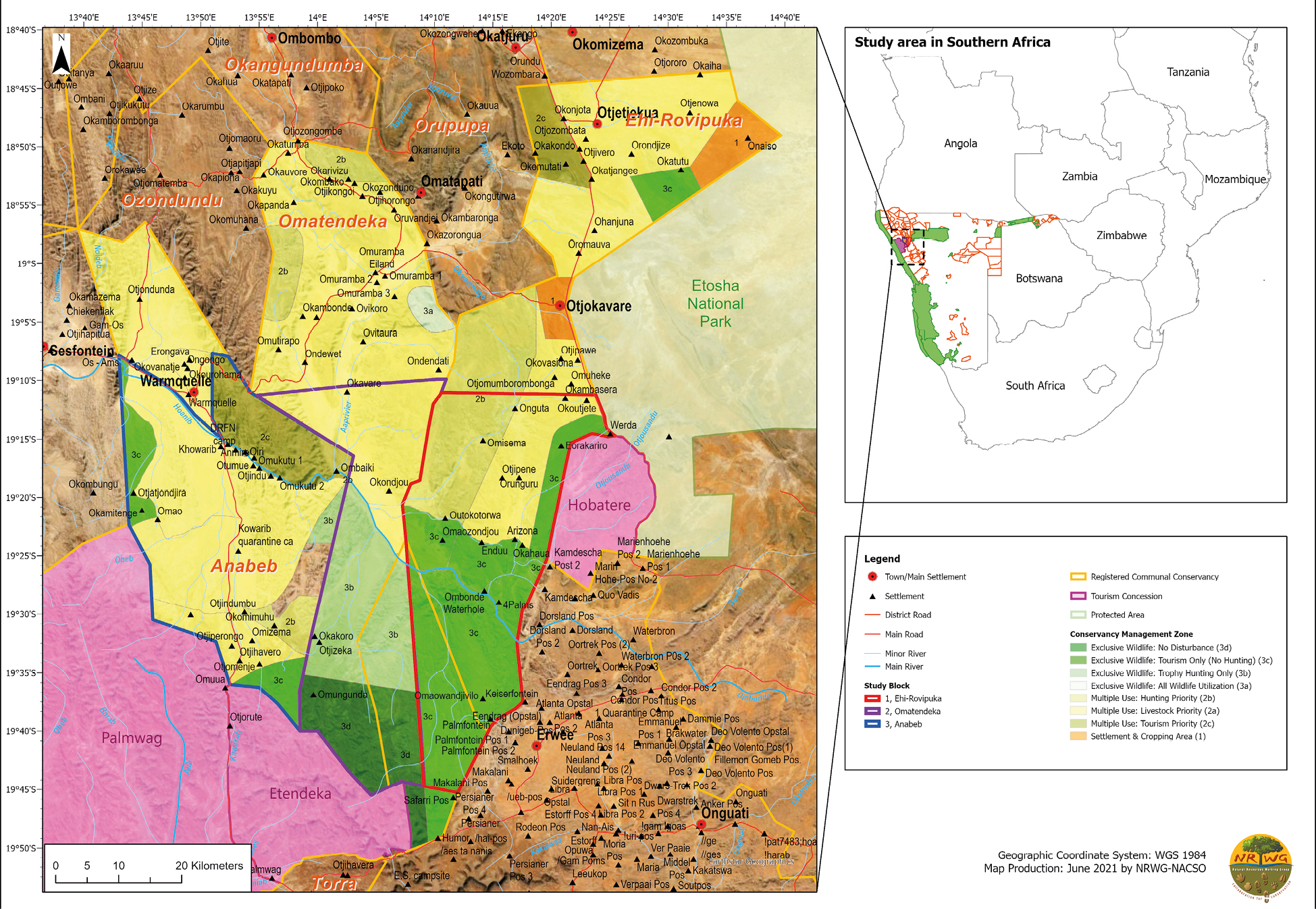
Fig. 19.1 Map showing the location of the study areas, conservancy zones and protected areas in between Etosha National Park and the Palmwag Tourism Concession in Namibia. Map © NACSO Natural Resources Working Group25 (NRWG), 2022,26 used with permission, CC BY-NC-ND 4.0.
Although HLC may be imminent where humans and large carnivores share space and resources, variable availabilities of prey might drive carnivores into more intensified proximity with humans. Animals live here in a seasonal and dynamic environment. Variations in weather conditions can negatively impact primary production, reducing resources available to herbivores, this lack of available resources cascading through the food chain. Animal life-history traits, such as reproduction, recruitment, growth, dispersal or migration, are connected with seasonality, as well as the dynamics of unpredictable variability in rainfall. There is limited data on seasonal variation in the spatial habitat lions use at the nexus of wildlife and multi-use areas. This information is likely crucial for reducing spatial-temporal overlap between lions and livestock. Understanding animal activities at different spatial and temporal scales will improve the management of factors that govern resources and habitat selection.27 The desert lion home range size, population structures, social behaviours, and diet are extensively studied (see Chapters 17 and 18).28 Little is known about seasonal livestock variation in their areas, however, and little emphasis is placed on how landscape features influence the level and extent of predation on livestock. The heterogeneous environment inhabited by both lions and people needs proper assessment to fully understand human-lion interactions.
Managing the shared landscape in Namibia’s CBNRM context is becoming a challenge. For the years since the 1996 Nature Conservation Amendment Act that made establishment of communal area conservancies possible, wildlife rather than livestock monitoring has been the priority. No livestock number or movement records can be found at any conservancy office. This leads to the following questions. Is there any balance between conservation and farming? Are we managing shared landscapes using the cut-and-paste tactic of Protected Area policy and thinking? Do we value the human equation in the CBNRM context? Considering these questions, this study collared goats to understand their seasonal movement in multiple used landscapes.
Advanced animal tracking technology allows ecologists to better understand animal behaviour without directly contacting the studied species. Livestock movement data are obtained using Global Positioning System (GPS) tracking data (see Chapter 17). Twelve goats were randomly selected from villages near wildlife areas between three conservancies: Anabeb, Omatendeka and Ehi-Rovipuka (see Figures 19.2 and 19.3). Mature male (those over 3 years of age) goats were used in this study due to their characteristic social dominance rank, which is determined by size and age, i.e. the older and larger the animals, the higher they become in the dominant social hierarchy.29 The 12 goats were fitted with Savannah FlexTrack collars for two years due to battery lifespan. The GPS collars record GPS locations at one-hour intervals daily. Each GPS collar records 18 hours daily, from 0600 to 2400. To reduce battery usage, all 12 Collars are set to transmit data at the interval of 1440 minutes, i.e. once a day at mid-day (1200). It is important to note that although it is the goats that are being monitored, in reality it is the farmers’/herders’ choices of where the goats should be taken for grazing/browsing that is being monitored. Goats are taken out by herders, and those decisions are discussed with the wider group at a farm.
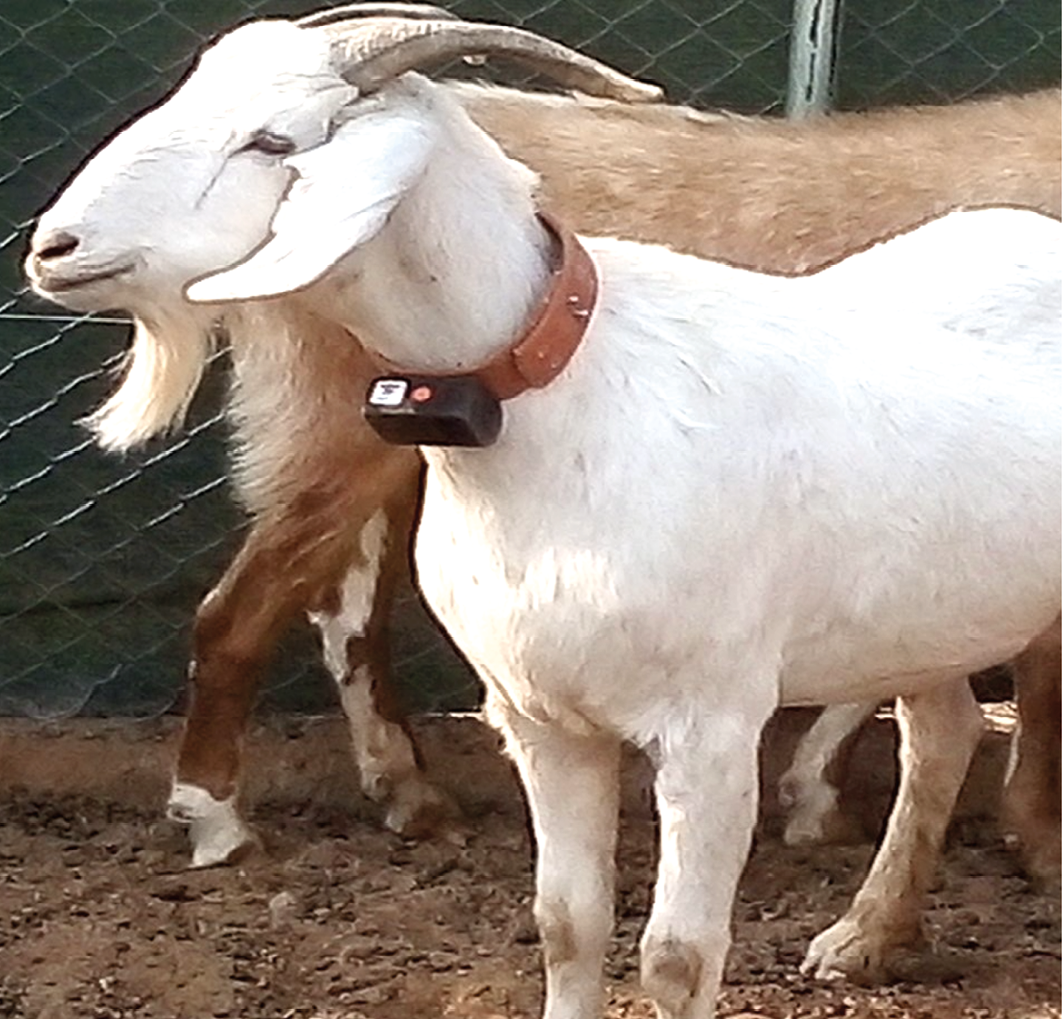
Fig. 19.2 A collared goat at !Nao-dâis/Otjorute village. © Uakendisa Muzuma, 2022, CC BY-NC-ND 4.0.
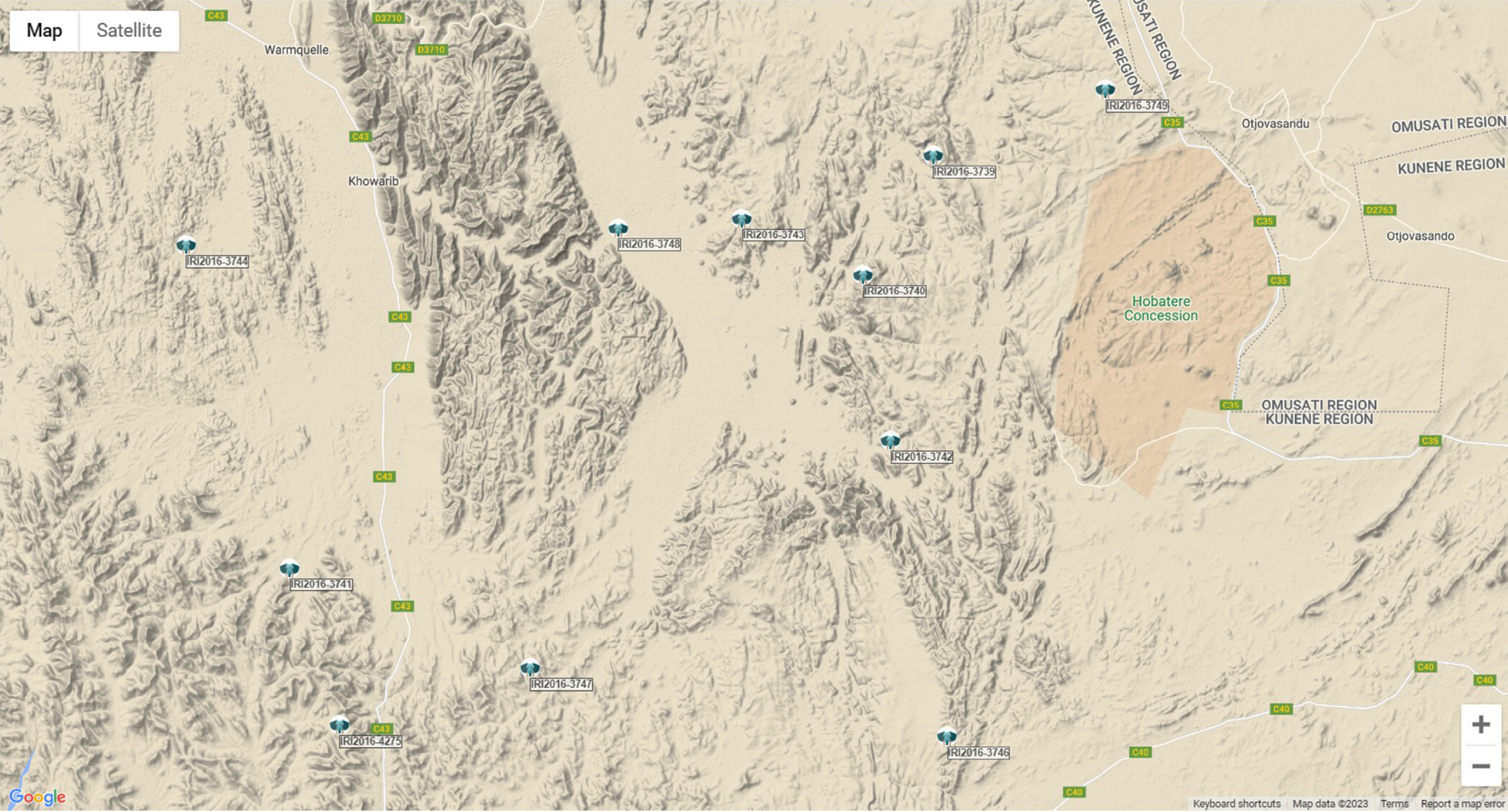
Fig. 19.3 Map showing the farm locations of 11 of the collared goats in this study (blue markers).
© Author’s data, CC BY-NC-ND 4.0.
The spatial movement data of collared goat #3742 based in Ehi-Rovipuka Conservancy in Figure 19.4, and of lion OPL-18 in Figure 19.5, illustrate the home ranges with some overlap for two animals of these two species. The goat spends most of the wet season in multiple-use areas, i.e. conservancy areas where human activities such as farming are allowed. In contrast, the lion spends most of her time in the wildlife areas, i.e. areas demarcated by conservancies for wildlife breeding and grazing, mostly to the west of the movements of the goat monitored here. Habitat overlap during dry seasons is mainly due to farmers moving into wildlife areas in search of better grazing/browsing for their livestock. No other study has looked at the spatial movement data of livestock and lions to understand habitat use in the north-west and in Namibia at large. This information is critical for mitigation measures for villages adjacent to wildlife areas.
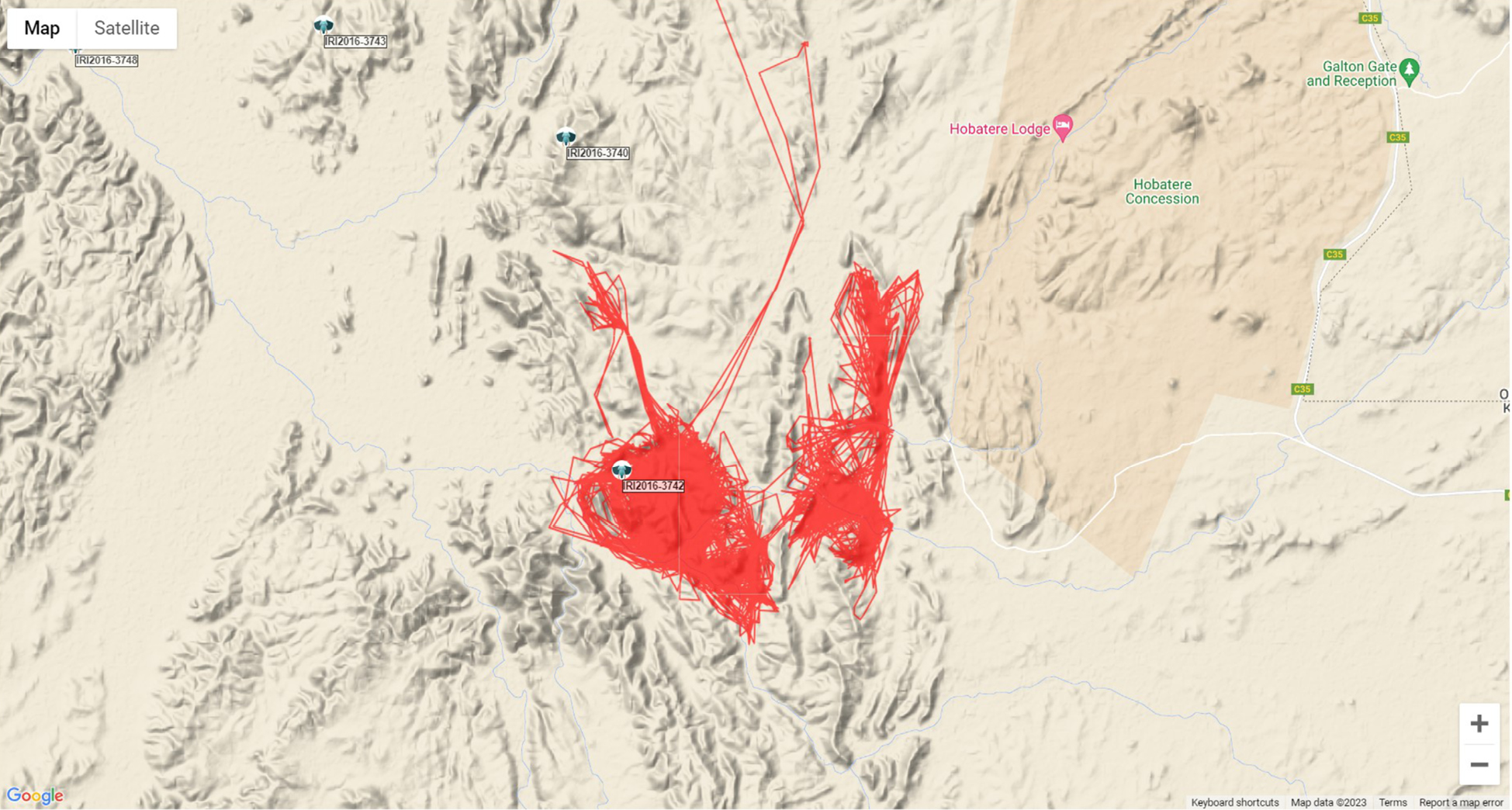
Fig. 19.4 Map showing movement data for a collared goat (#3742) from 1.9.2022 to 8.2023. © Author’s data,
CC BY-NC-ND 4.0.
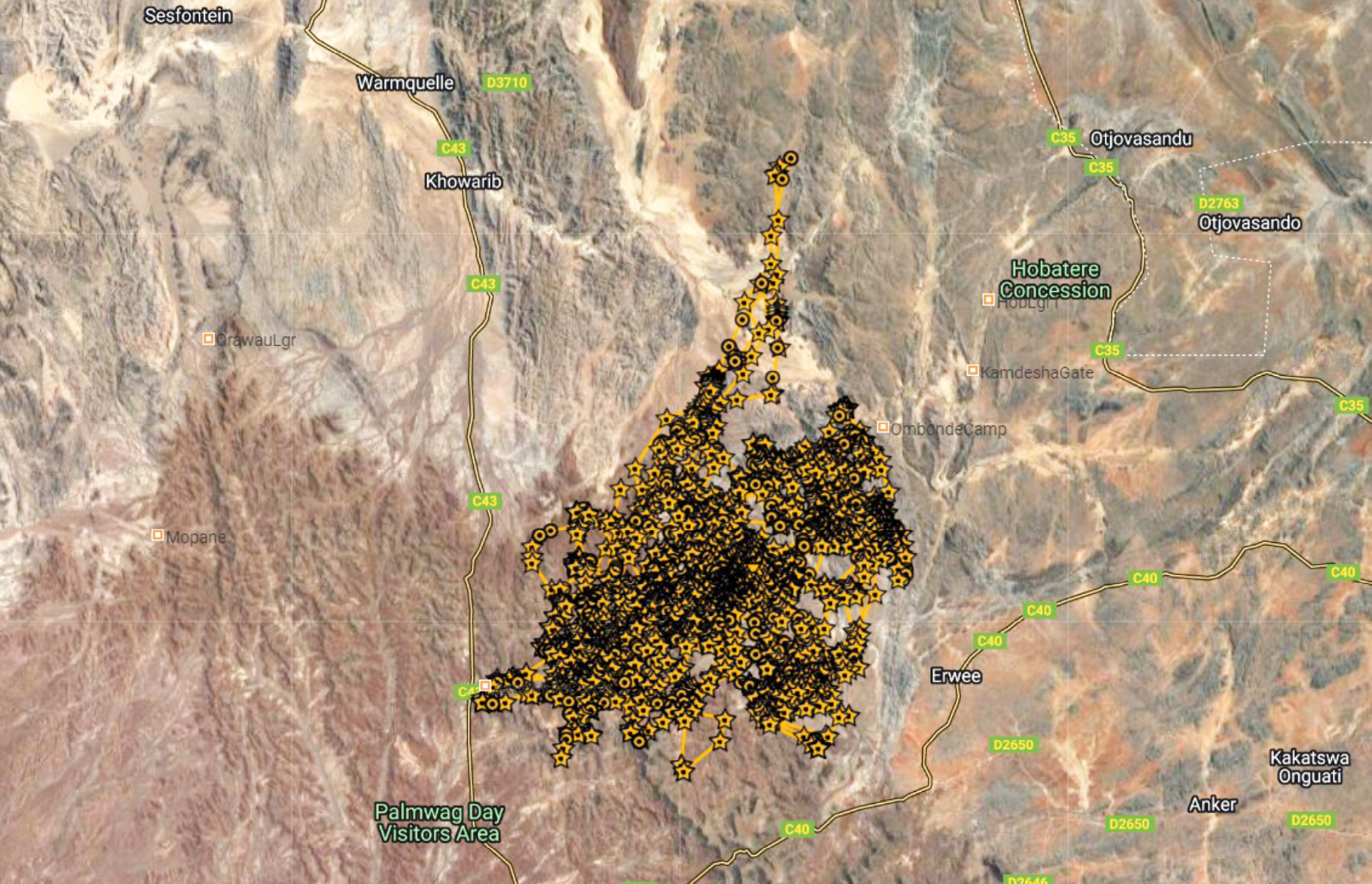
Fig. 19.5 Map showing movement data of collared lion OPL-18 from 1.9.2022 to 8.10.2023. © Author’s data,
CC BY-NC-ND 4.0.
19.3 Rethinking the CBNRM-livestock policy interface
The Revised National Policy on Human Wildlife Conflict Management 2018–202730 stipulates that no compensation will be provided to farmers whose livestock are attacked or killed in areas set aside for wildlife conservation. This means that farmers are taking a risk when grazing their livestock in conservancy-designated wildlife areas, because they will not be compensated for losses in these areas. In recent years, more lion poisoning has been recorded in the wildlife areas due to retaliatory killing by “illegal settlers”: i.e. people that are not members of the conservancy or residents of the area, but come from other areas or conservancies, searching for grazing for their livestock and settling without permission from the traditional authority or conservancy management (on such land disputes, also see Chapters 3 and 6). From a policy perspective, however, it is essential to revisit compensation mechanisms for farmers settled legally in areas designated for wildlife in the context of CBNRM. The prolonged drought will keep forcing people to utilise ephemeral rivers running through wildlife areas due to better grazing and the availability of foods such as acacia pods. If they are not going to be compensated for their losses they will resort to taking drastic retaliatory measures against predators, as has already been seen.
The policy thus needs to consider CBNRM. Local people allocated their lands to wildlife, with limited knowledge of the status of wildlife corridors, habitat fragmentation, livestock and wildlife carrying capacity, climate changes and human-induced changes such as development and settlement. At the time, there was no thorough consultative input from experts on these subjects to advise them on the future. The current conservancy wildlife management plan is not flexible and does not indicate when or how farmers should settle in “wildlife core areas”. The current view is more focused on conservation for development, while the farming component is missing. This will privilege those who benefit directly from conservation development, e.g. through job creation in the tourism sector, but may negatively impact those farmers who make a living from their livestock.
19.4 Conclusion
Monitoring the spatial movements of wildlife and livestock in conservancies is essential to ensure proper records for decision-making and area-specific mitigations. With the increase in lion retaliatory killings around and within wildlife areas, research is needed to understand the impacts of the Revised National Policy on Human Wildlife Conflict Management. The status of “wildlife corridors” needs to be assessed, in terms of their contributions to the mobility of animals such as lions and elephants if the connectivity of corridors is not maintained (also see discussion in Chapter 13). The “corridor” between ENP and SCNP is supposed to maintain the free movement of animals from one landscape to another. Lions, however, are sometimes killed by residents on communal land when these animals leave National Parks or tourism concession areas.
This context warrants research to better understand the effects of human settlements situated between parks and concessions areas, given understandings of these areas as wildlife corridors for large carnivores and megaherbivores. The situation is critical given that people have lived for a long time in these areas as well as within areas now designated as national parks and tourism concessions (as highlighted in Chapters 12, 13, 14 and 15). There is also a need to understand the impacts of these designations on human settlement and land use. It is essential to remind CBNRM practitioners of the importance of understanding that community conservation needs to align with development aims, including those of sustainable farming. Otherwise, farmers’ associations and others may take an “anti-conservation” stance that will hinder the effectiveness of conservation-oriented implementations (see Chapter 3). Overall, then, it is important that initiatives in north-west Namibia (and elsewhere) adhere to the following three pillars of CBNRM: stakeholder involvement, public participation, and inter-organisational coordination.
Bibliography
Barroso, F.G., Alados, C.L. and Boza, J. 2000. Social hierarchy in the domestic goat affects food habits and production. Applied Animal Behaviour Science 69(1): 35–53, https://doi.org/10.1016/S0168-1591(00)00113-1
Barua, M., Bhagwat, A.A. and Jadhav, S. 2013. The hidden dimensions of human-wildlife conflict: Health impacts, opportunity and transaction costs. Biological Conservation 157: 309–16, https://doi.org/10.1016/j.biocon.2012.07.014
Bauer, H. and de Iongh, H.H. 2005. Lion (Panthera leo) home ranges and livestock conflicts in Waza National Park, Cameroon. African Journal of Ecology 43: 208–14, https://doi.org/10.1111/j.1365-2028.2005.00570.x
Blackburn, S., Hopcraft, G.C., Ogutu, J.O., Matthiopoulos, J. and Frank, L. 2016. Human-wildlife conflict, benefit-sharing and the survival of lions in pastoralist community-based conservancies. Journal of Applied Ecology 53: 1195–205, https://doi.org/10.1111/1365-2664.12632
Dickman, A.J., MacDonald, E.A. and MacDonald, D.W. 2011. A review of financial instruments to pay for predator conservation and encourage human-carnivore coexistence. Proceedings of the National Academy of Sciences of the United States of America 108: 13937–44, https://doi.org/10.1073/pnas.1012972108
Fentaw, T. and Duba, J. 2017. Human-wildlife conflict among the pastoral communities of southern rangelands of Ethiopia: The case of Yebello protected area. Journal of International Wildlife Law and Policy 20(2): 198–206, http://dx.doi.org/10.1080/13880292.2017.1346352
Frank, L.G., Maclennan, S.M., Hazzah, L., Bonham, R. and Hill, T. 2006. Lion Killing in the Amboseli–Tsavo Ecosystem, 2001–2006, and Its Implications for Kenya’s Lion Population. Project report for Living with Lions, Nanyuki, Kenya, http://www.lionconservation.org/AnnualReports/2006-Lion-killing-in-Amboseli-Tsavo-ecosystem.pdf
González, L.A., Bishop-Hurley., Handcock, RN. and Crossman, C. 2015. Behavioural classification of data from collars containing motion sensors in grazing cattle. Computers and Electronics in Agriculture 110: 91–102, https://doi.org/10.1016/j.compag.2014.10.018
Hadidian, J. 2015. Wildlife in US cities: Managing unwanted animals. Animals 5: 1092–113, https://doi.org/10.3390/ani5040401
Hemson, G. 2003. The Ecology and Conservation of Lions: Human-wildlife Conflict in Semi-arid Botswana. Unpublished PhD Thesis, University of Oxford.
Heydinger, J.M., Packer, C. and Tsaneb, J. 2019. Desert-adapted lions on communal land: Surveying the costs incurred by, and perspectives of, communal-area livestock owners in northwest Namibia. Biological Conservation 236: 496–504, https://doi.org/10.1016/j.biocon.2019.06.003
Holechek, J.L., Peiper, R.D. and Gerbe, C.H. 1989. Range Management Principles and Practices. Englewood Cliffs, N.J.: Prentice-Hall.
Holechek, J. and Valdez, R. 2018. Wildlife conservation on the rangelands of eastern and southern Africa: Past, present, and future. Rangeland Ecology & Management 71: 245–58, https://doi.org/10.1016/j.rama.2017.10.005
Jones, B. 2010. The evolution of Namibia’s communal conservancies. In Nelson, F. (ed.) Community Rights, Conservation and Contested Land: The Politics of Natural Resource Governance in Africa. Abingdon, Oxon: Earthscan, 106–20.
LeFlore, E.G., Fuller, T.K., Tomeletso, M. and Stein, A.B. 2019. Livestock depredation by large carnivores in northern Botswana. Global Ecology and Conservation 18: e00592, https://doi.org/10.1016/j.gecco.2019.e00592
Lindsey, P.A., Miller, J.R.B., Petracca, L.S. et al. 2018. More than $1 billion needed annually to secure Africa’s protected areas with lions. Proceedings of the National Academy of Sciences 115(45): E10788–96, https://doi.org/10.1073/pnas.1805048115
MET 2017. Human-Lion Conflict Management Plan for North West Namibia. Windhoek: Ministry of Environment and Tourism.
MET 2018. Revised National Policy on Human Wildlife Conflict Management 2018–2027. Windhoek: Ministry of Environment and Tourism.
Nuulimba, K. and Taylor, J.J. 2015. 25 Years of CBNRM in Namibia: A retrospective on accomplishments, contestation and contemporary challenges. Journal of Namibian Studies 18: 89–110, https://namibian-studies.com/index.php/JNS/article/view/110/110
Owen-Smith, G. 2010. An Arid Eden: One Man’s Mission in the Kaokoveld. Johannesburg: Jonathan Ball Publishers.
Owen-Smith, N. 2013. Daily movement responses by African savanna ungulates as an indicator of seasonal and annual food stress. Wildlife Research 40: 232–40, https://doi.org/10.1071/WR13024
Packer, C., Ikanda, D., Kissui, B. and Kushnir, H. 2005. Lion attacks on humans in Tanzania-understanding the timing and distribution of attacks on rural communities will help to prevent them. Nature 436: 927–28, https://www.nature.com/articles/436927a
Packer, C., Loveridge, A., Canney, S. et al. 2013. Conserving large carnivores: Dollars and fence. Ecology Letters 16: 635–41, https://doi.org/10.1111/ele.12091
Ripple W.J., Estes, J.A., Beschta, R.L., Wilmers, C.C., Ritchie, E.G., Hebblewhite, M., et al. 2014. Status and ecological effects of the world’s largest carnivores. Science 343(6167), https://www.science.org/doi/10.1126/science.1241484
Rust, N. 2015. Understanding the Human Dimensions of Coexistence Between Carnivores and People: A Case Study in Namibia. Unpublished PhD Thesis, University of Kent.
Sigaud, M., Mason, T.H.E., Barnier, F., Cherry, S.G. and Fortin, D. 2020. Emerging conflict between conservation programmes: When a threatened vertebrate facilitates the dispersal of exotic species in a rare plant community. Animal Conservation 23(6): 660–69, https://doi.org/10.1111/acv.12579
Simon, R.N. and Fortin, D. 2020. Crop raiders in an ecological trap: Optimal foraging individual-based modelling quantifies the effect of alternate crops. Ecological Applications 30: e02111, https://doi.org/10.1002/eap.2111
Smit, E. 2022. Lions primarily killed in retaliatory killings. 12.8.2022 Namibian Sun, http://www.namibiansun.com/environment/lions-primarily-killed-in-retaliatory-killings2022-08-12
Stander, P.E. 1991. Demography of lions in the Etosha National Park, Namibia. Madoqua 18(1): 1–9, https://journals.co.za/doi/pdf/10.10520/AJA10115498_339
Stander, P.E. 1992a. Cooperative hunting in lions: The role of the individual. Behavioural Ecology and Sociobiology 29(6): 445–54, https://link.springer.com/article/10.1007/BF00170175
Stander, P.E. 1992b. Foraging dynamics of lions in a semi-arid environment. Canadian Journal of Zoology 70: 8–21, https://doi.org/10.1139/z92-002
Stander, P.E. 1994. Ecology and Hunting Behaviour of Lions and Leopards. Cambridge.
Stander, P.E. 2000. Conservation of Lions and Other Large Carnivores in the Kunene Region, Namibia: Population Ecology and Long Term Monitoring of Free-ranging Populations in a Marginal and Arid Environment. Unpublished Report. Windhoek, Namibia.
Stander, P.E. 2001. Research Progress Report—Population Ecology and Long Term Monitoring of Free-Ranging Populations in Namibia’s Marginal and Aid Environments. Windhoek.
Stander, P.E. 2004. Population Ecology and Distribution of Lions in the Kunene and Erongo Regions, Namibia. Unpublished Report. Windhoek, Namibia.
Stander, P.E. 2006a. Population ecology and demography of Kunene Lions, January 2006. Unpublished Report. Windhoek, Namibia.
Stander, P.E. 2006b. Nocturnal Behavior of Desert Lions. Desertlion.info, 31.10.2006.
Stander, P.E. 2008a. Desert Lion Conservation, GPS Radio Collars—Hoaruseb Pride. Desertlion.info, https://web.archive.org/web/20081212035510/http://www.desertlion.info/gpscollars/gps_44.html
Stander, P.E. 2008b. Desert Lion Conservation News, September-October, 2008. Desertlion.info, https://web.archive.org/web/20081019014011/http://www.desertlion.info/news.html
Stander, P.E. 2008c. Desert Lion Conservation News, October-December, 2008. Desertlion.info, https://web.archive.org/web/20081211092034/http://www.desertlion.info/news.html
Stander, P.E. 2008d. Tourism and the Conservation of Desert Lions in Namibia, https://lionrangers.org/wp-content/uploads/2020/08/Stander2008ConservationTourismDesertAdapted.pdf
Stander, P.E. 2009. Movement Patterns and Activity of Desert-Adapted Lions in Namibia: GPS Radio Collars, https://lionrangers.org/wp-content/uploads/2020/08/Stander2009MovementPatternsDesertAdapted.pdf
Stander, P.E. 2010. The Impact of Male-biased Mortality on the Population Structure of Desert-adapted Lions in Namibia. Unpublished Report, http://lionrangers.org/wp-content/uploads/2020/08/Stander2010Male-basedMortality.pdf
Stander, P.E. and Hanssen, L. 2003. Population Ecology of Desert-adapted Lions in the Kunene Region, Namibia. Windhoek, Namibia, https://lionrangers.org/wp-content/uploads/2020/08/Stander2003LionStudyKunene.pdf
Stuart-Hill, G., Diggle, R., Munali, B., Tagg, J. and Ward, D. 2005. The Event Book System: A community-based natural resource monitoring system from Namibia. Biodiversity and Conservation 14: 2611–31, https://link.springer.com/article/10.1007/s10531-005-8391-0
Sullivan, S. 2009. Green capitalism, and the cultural poverty of constructing nature as service-provider. Radical Anthropology 3: 18–27.
Sullivan, S. 2016. Three of Namibia’s most famous lion family have been poisoned – why? The Conversation
23.8.2016, https://theconversation.com/three-of-namibias-most-famous-lion-family-have-been-poisoned-why-64322
Ujvári, M., Baagøe, H.J., and Madsen, A.B. 1998. Effectiveness of wildlife warning reflectors in reducing deer-vehicle collisions: A behavioural study. Journal of Wildlife Management 62: 1094–99, https://www.jstor.org/stable/3802562
Urness, P.J. 1982. Livestock as tools for managing big game range in the Intermountain West. In Peek, J.M. and Dalke, P.D. (eds.) Wildlife Livestock Relationships Symposium Proceedings 10 University of Idaho Moscow, 20–31.
Vavra, M. 2005. Livestock grazing and wildlife: Developing compatibilities. Rangeland Ecology of Management 58: 128–34, https://doi.org/10.2111/1551-5028(2005)58%3C128:LGAWDC%3E2.0.CO;2
Venkataraman, M., Johnson, P.J., Zimmermann, A., Montgomery, R.A. and MacDonald, D.W. 2020. Evaluation of human attitudes and factors conducive to promoting human-lion coexistence in the Greater Gir landscape, India. Oryx 55(4): 589–98, https://doi.org/10.1017/S0030605319000760
Woodroffe, R. and Ginsberg, J.R. 1998. Edge effects and the extinction of populations inside protected areas. Science 280: 2126–28, https://www.science.org/doi/10.1126/science.280.5372.2126
1 (2018)
2 The term “ecosystem services” has been used for several decades to denote the benefits to humans provided by the natural world. For an outline of the history of the term, its contested meanings and implications see Sullivan (2009).
3 Dickman et al. (2011), Venkataraman et al. (2020)
4 Barua et al. (2013)
5 Ujvári et al. (1998), Bauer & de Iongh (2005), Packer et al. (2005), Ripple et al. (2014), Hadidian (2015), Sigaud et al. (2020), Simon & Fortin (2020)
6 (2013)
7 Holechek & Valdez (2018)
8 Urness (1982), Holechek et al. (1989), Vavra (2005), Holechek & Valdez (2018)
9 Rust (2015)
10 Fentaw & Duba (2017)
11 Frank et al. (2006)
12 Hemson (2003), LeFlore et al. (2019)
13 Woodroffe & Ginsberg (1998), Blackburn et al. (2016)
14 Sullivan (2016)
15 MET (2017), Stuart–Hill et al. (2005)
16 Jones (2010), Owen-Smith (2010), Heydinger et al. (2019)
17 Nuulimba & Taylor (2015)
18 MET (2017)
19 For example, Sullivan (2016), Smit (2022)
20 MET (2017)
21 Ibid.
22 Ibid.
23 Stander (2000)
24 Sullivan (2016), MET (2017), Heydinger et al. (2019)
25 https://www.nacso.org.na/working-groups/natural-resources-working-group
26 Note that many localities on this map also have Khoekhoegowab names.
27 Owen-Smith (2013), Gonzales et al. (2015)
28 Stander (1991, 1992a, b, 1994, 2000, 2001, 2004, 2006a, b, 2008a, b, c, d, 2009, 2010), Stander & Hanssen (2003)
29 Barroso et al. (2000)
30 MET (2018: 23)
